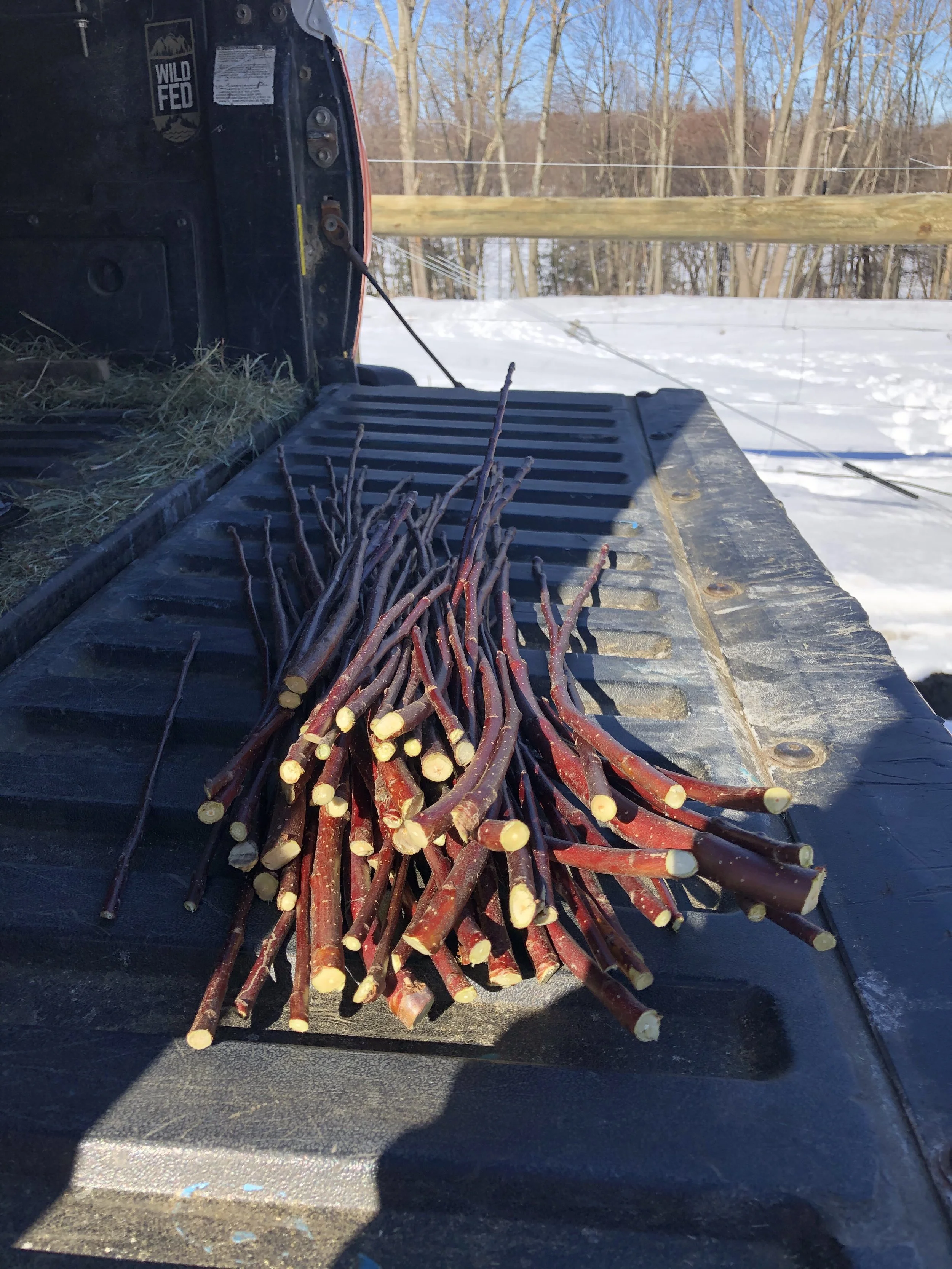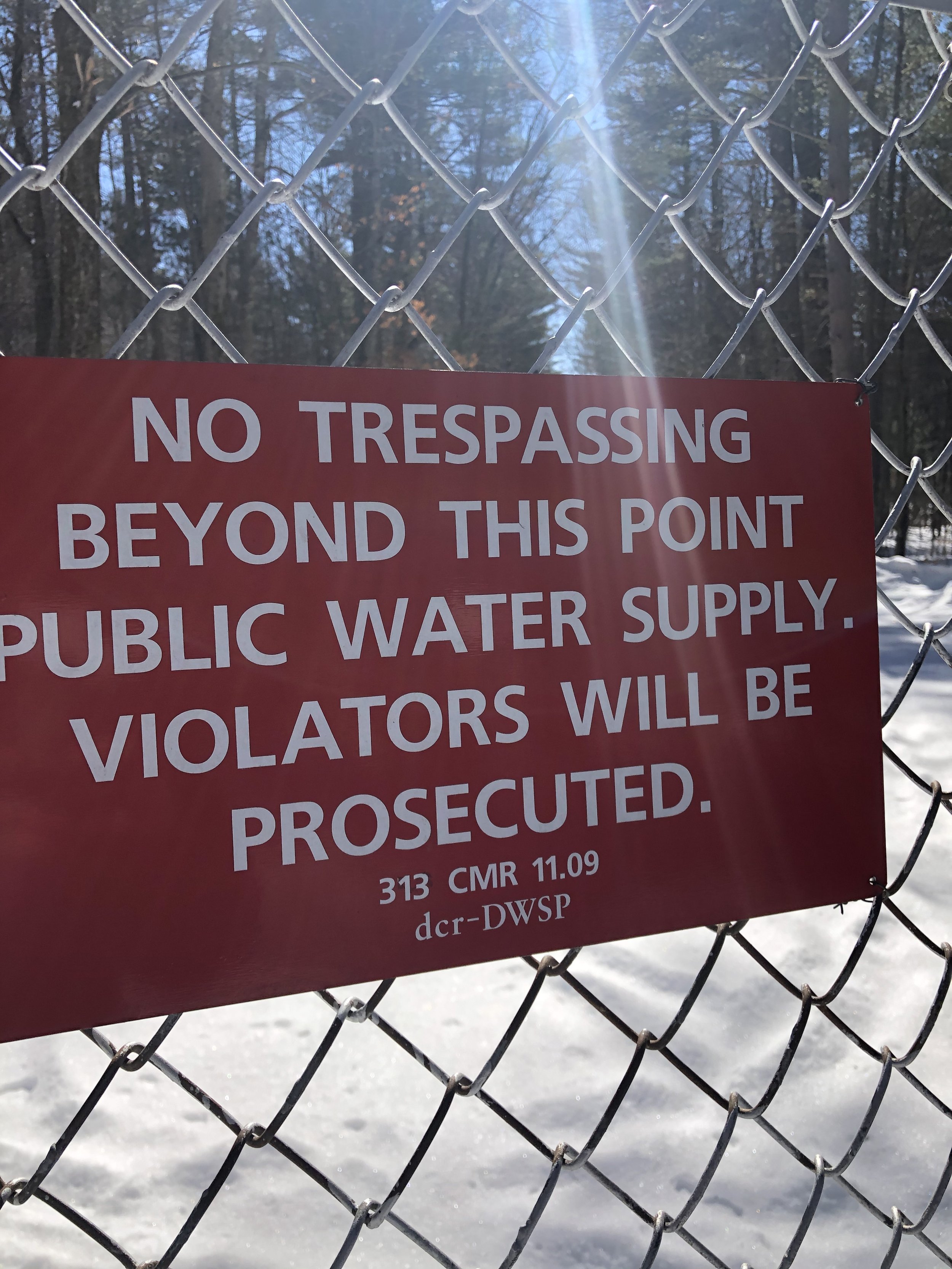Wild Pommage
Dante Pilkington
Pom-mage
Noun
1. The pulpy residue remaining after an apple has been crushed to extract its juice.
2. The medley of apples, with a distinct taste and physical characteristics, of a specific region.
“Vines are lowly in the hierarchy of plants. They are a parasitic plant. Vines require trellising because in nature they sap the strength of a stronger plant on the hierarchy. But trees are self-sufficient. They can nourish and heal themselves. They can withstand and adapt to drought and frost. Each tree is a fortress and a garden—and that is why apple trees stand at the top of the hierarchy.”
Matt waxed poetic, his untamed black beard poking out from under his apple-print cloth mask, as we drove down the snow-covered gravel roads on our way to the Quabbin Reservoir in search of one his “Mother Trees”. Matt Kominsky, who also goes by his nom-de-Pomona (Pomona, the Latin word for orchard fruit, and the goddess who watches over them) “Gnarly Pippins”, has dedicated the past eight years of his life to the apple. I am an apple novice, but I sympathize with Matt’s apple-bias. Apples have always taken a back seat to grapes. Wild apple cider, and cider in general, is making a popular resurgence, by basking in the afterglow of the natural wine craze. But wine culture, and even its funky off-shoot, natural wine, can often feel exclusionary to the point of gatekeeping.
Articles such as the New Yorker’s “How Natural Wine Became a Symbol of Virtuous Consumption” and “Is Natural Wine Only for White People”, write about the natural wine scene being dominated by well-heeled urban millennials, decked out in their Marfa-chique felt hats, enjoying their naturally yeasty beverages at exorbitant prices. The truth to Gnarly Pippin’s sentiment peels back the curtain on natural wine. Behind the pseudo-homespun ferment, behind the gild of the orange glow of its elixir, behind the George Condo-esque labels, grapes are fussy. And wine is for wealthy people, who, regardless of how natural the fermentation process, only dare to sip varieties that grow in fancy, far-flung regions of the world. But the apple is for everybody.
While the anemic grape vine skulks around the New England backwoods, relegated only to its heartiest version, the tough-skinned wild catawba grape, apples of a near-infinite abundance and variety grow free. The world of the drinkable grape is quite rigid—the only variation in the Pinot noir grape grown in Oregon, New Zealand, South Africa, and France is the slight differences in the soil and climate. But in the woods just past the backyards from Philly up to Boston lay a variety of wild apples that grow in such a cacophony of shapes and flavors, that, for centuries, it has boggled the minds of the most rigid biologists who attempt to classify their wild abundance.
But one man is on a mission not to tame the wild apple, but rather, to be its steward.
On our way to the Quabbin Reservior, we pull off to the side of the road. Matt hopped out to scale a tree with the burly grace of a broad-shouldered rock climber. At the top, he announced, “This tree is called Trousers.”
Of course, this begs the question, why a grown man would name a tree as if it were the name of a talking teddy bear in a British animated children’s tv show, “Oh Trousers you naughty, naughty bear! Give me back my tea biscuit posthaste!” etc.
Gnarly Pippins frowned at the question. There is nothing silly about Trousers. “It has a russet band around the calyx, which is the bottom of the fruit where the flower once grew. The fruit produces two very different colors on the top and the bottom. So each fruit from this tree has trousers.”
And Trousers is not just an ordinary tree, it’s a “mother tree”. All apples are near identical clones that trace their origins back to a single mother tree. For instance the 2.7 billion pounds of Red Delicious apples grown each year comes from grafts, fresh branches, that come from one original mother tree on a farm in Iowa. The cloning nature of apple grafting, has succumbed to sinister corporate industrialization. Red Delicious is patented, like an iPhone or a Tesla, and any ordinary member of the public who attempts to graft a Cosmic Crisp apple can be taken to court for copy right infringement. The most shameful part of this patenting, is it bends the wild-hearted apple down to the level of the lowly grape. Cosmic Crisp apples and Pinot noir grapes can be found growing, row after identical row, on almost every continent.
Gnarly Pippins is on a quest to unshackle the apple, giving the people their own ability to graft the distinctive flavors from wild mother trees all over the Northeast woods. These trees have never been grafted, have never been cloned, and therefore branch out in variety in flavor, size, color, shape, texture, and even smell. Imagine sipping on something that smells like the flowers in a hay field, has the effervescence of champagne, and yet there is the distinct little tart tickle at the back on the tongue that tells your brain, this nectar comes from humble apple. And, better still, no corporate law firm is stopping you from making it yourself.
In depths of winter, when the trees are in their most dormant state, Gnarly Pippins drives as far east as the Hudson River in New York and as far north as the White Mountains in New Hampshire to harvest their scions, the branches used for grafting, from the mother trees.
“I have a guy in Chagrin Falls, Ohio, who buys over two hundred feet of scion wood every year.”
Gnarly Pippins tells me as he balances on one of Trouser’s limbs to snip the auburn colored scion shoots. Coming across a dead limb, Gnarly unholsters his homemade handsaw from his side like a cowboy’s six-shooter.
I stood on the shoulder of the road, eyeing people driving by in their cars eyeing Gnarly Pippins, fifteen feet off the ground, snipping and sawing at Trousers. The tree sits off the side of a pretty busy road. I ask who owns the land.
Gnarly Pippins shrugs, “The trees do not follow any of the political boundaries placed around them.”
I wondered what political boundaries Gnarly Pippins did adhere to, as we came to a fenced off road with a large red “No Trespassing” sign fashioned into the chain link that separated us from the Quabbin Reservoir. Luckily, Gnarly took out a set of keys and started to fiddle with the bolt lock on the fence.
As we trudged down a snowed-in road into the Quabbin, Gnarly explained, “A few years back I submitted a proposal to the Massachusetts Department of Conservation. They dammed the river here in 1939 to create the reservoir and flooded five towns. I found public records that said that these towns, before prohibition, were known for their cidermaking. I wanted to see if any of these pre-prohibition apple trees still existed. Maybe find a missing link between when the Dutch and the English first brought apples to this area four hundred years ago and the wild cider apples of today.”
I asked if he had found what he was looking for, “No. But I did find what I call, ‘The Beauty of the Quabbin.’”
About a mile down the road, in a small field stood a magnificent apple tree with a twirling trunk, which unfurled four strong limbs, splayed outwards toward the clear blue sky.
On our way back from snipping the scion wood from The Beauty of the Quabbin, there was an old man waiting for us next to Gnarly Pippins’ truck. The man’s house was perched right next to the fence guarding the reservoir, and he wanted to know what we had been doing inside the Quabbin.
Matt explained his scion wood collection and his preservation of mother trees.
“What are you looking for in one of these mother trees?” The old man asked.
“I want to create a pommage—a catalogue of physical characteristics, distinct shape, color, quality of tannins for cider pressing, and genetic fitness of the trees all over this area of the northeast, hopefully to stave off fire blight and other forms of infestation that are on the rise due to global warming making the summers warmer and wetter.”
“Also.” I offered, grinning under my mask, “they taste delicious.”
To procure cider made from Gnarly Pippins' trees, please visit carrsciderhouse.com or in person at 295 River Drive, Hadley, MA to pick up a damn fine bottle of truly wild cider.




